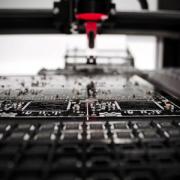Artificial intelligence (AI) has many applications in supply chain and logistics. These range from automating the analysis and reporting on global supply chain activities and optimizing supply chain planning and execution to predictive applications for scheduling, strategic sourcing, and remote monitoring and predictive maintenance.
Major drivers for applying AI in the supply chain include demand for greater visibility and transparency into supply chain data, processes, and execution, and a need to reduce risk and satisfy customer demands.
AI-Powered Supply Chain Analytics
One area where we are seeing considerable innovation involves AI applied to supply chain analytics. Global supply chains rely on data from all over the world. Monitoring and analyzing this data is essential for keeping track of how all the various activities comprising a supply chain are functioning. Companies are turning to AI-based supply chain analytics that will allow them to incorporate and analyze all sorts of data — ranging from operational systems to weather data, traffic reports, and regulatory information — to develop a more encompassing and detailed view of global supply chain issues.
This is a wide-open field, and we are seeing efforts by many suppliers to develop AI-powered supply chain analytics. This includes the major enterprise software players like IBM, Oracle, and SAP, and focused supply chain planning and analytics companies like Blume Global, Infor, Intrigo Systems, JDA Software, Panjiva, Splice Machine, SwanLeap, ThroughPut Inc., and Trensant, Inc.
The Big Potential: AI and Converging Technologies
But when considering AI’s potential impact on the supply chain, one really must consider the convergence of several technological trends. These include advances in big data analysis, streaming analytics, machine learning (ML), blockchain, intelligent robotics, and, perhaps most significant, the Internet of Things (IoT).
By combining the various AI technologies with the IoT, companies can monitor and manage supply chain processes and the condition and movement of the various assets that comprise a supply chain — in real time. Consequently, it is more than just core AI technologies like ML, neural networks, and natural language processing (NLP) that are impacting supply chains. You must also consider new offerings like drones — for aerial inspection of large or sensitive facilities — and connected products and sensor-enabled machinery, vehicles, and shipping assets, such as containers, rail cars, packages, and transportation/shipping infrastructure.
In short, sensor-enabled and connected assets combined with intelligent monitoring and decisioning systems are becoming increasingly important for providing in-depth, real-time insight into supply chain activities, and for supporting advanced supply chain scenarios like remote monitoring and predictive maintenance on critical supply chain components and distributed operations.
AI and IoT
We are seeing many industry developments around these areas, too. For example, predictive maintenance and remote monitoring systems employing AI and IoT capabilities are now available as cloud service platforms. Importantly, such solutions are utilizing new model-building methods designed to take some of the headache out of AI development.
One example is Presenso. Presenso’s cloud-based predictive maintenance platform uses automated machine learning (Auto ML). Auto ML is a model-building technique that applies AI to make it easier for programmers not skilled in AI development to build, test, and train their own models through automated methods.
This is important because there currently is a severe shortage of personnel trained in AI development. As a result, companies striving to adopt advanced manufacturing and supply chain applications combining AI and IoT technologies can struggle when it comes to building and deploying predictive maintenance programs across their organizations. In effect, cloud platforms like Presenso automate ML processes, making such advanced technologies more accessible to maintenance, customer service, and supply chain management professionals.
Hybrid Supply Chain Systems Combing AI, IoT, and Blockchain
Applications combing IoT, AI, and blockchain hold the promise of allowing the development of advanced systems that can distribute machine intelligence and sensitive data broadly and securely across large numbers of connected supply chain assets and processes.
Some bleeding-edge organizations and vendors are now experimenting with hybrid supply chain applications and solutions that combine AI, IoT, and blockchain. But most of these developments are still proof-of-concept.
That said, hybrid supply chain systems employing AI, IoT, and blockchain are certain to have a huge impact on future supply chain operations. And we should expect to see such applications appearing in the next few years as vendors and industry consortia start rolling out new industry supply chain solutions combining these technologies.
AI and Robotics in Distribution Centers
As distribution and shipping centers become more integrated and complex, and robotic systems more intelligent and more versatile, companies will increasingly turn to the latter to handle more complicated tasks like order selection, fulfillment, unloading, and so on.
Commercial interest in this area is immense and is primarily being fueled by the rapid growth in e-commerce. Consequently, we are seeing many commercial efforts to advance the state of AI and robotics.
For example, Honeywell recently announced a strategic collaboration with Carnegie Mellon University to develop new AI and robotics solutions and practices to help companies utilize these technologies in their distribution centers. The focus is on intelligent robotics solutions for improving productivity and performance in fulfilling orders. This includes a next-generation architecture for controlling and operating multiple robotic applications. The platform will use ML to enable critical decision-making capabilities, intelligent motion functionality, collision avoidance, and reliable sensing to make it more practical for companies to deploy advanced robotics in dynamic, unpredictable environments like distribution and fulfillment centers.
Conclusion
This is a brief overview of how AI developments are starting to impact the supply chain. Probably the most important takeaway is that, in the not-too-distant future, we can expect new hybrid systems incorporating IoT, blockchain, and AI technologies that will support the monitoring and analysis of supply chain operations and intelligent decision making for evaluating and acting on the status of distributed supply chain assets and activities.
Finally, I’d like to get your opinion about AI’s role in the supply chain. You can comment at the link below, email me at chall@cutter.com, or call +1 510 356 7299 with your comments.



